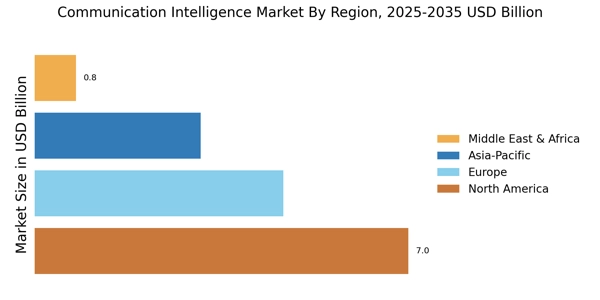Rising Demand for Enhanced Customer Engagement
The Communication Intelligence Market experiences a notable surge in demand for enhanced customer engagement solutions. Organizations increasingly recognize the importance of effective communication in fostering customer loyalty and satisfaction. As a result, companies are investing in advanced communication intelligence tools that facilitate personalized interactions. According to recent data, businesses that leverage communication intelligence report a 20% increase in customer retention rates. This trend indicates a shift towards prioritizing customer-centric strategies, where understanding customer preferences and behaviors becomes paramount. The Communication Intelligence Market is thus poised for growth as organizations seek to implement solutions that not only streamline communication but also enhance the overall customer experience.
Regulatory Compliance and Data Privacy Concerns
Regulatory compliance and data privacy concerns are increasingly influencing the Communication Intelligence Market. As data protection regulations become more stringent, organizations are compelled to adopt communication intelligence solutions that ensure compliance while safeguarding customer information. This necessity is reflected in the growing investment in secure communication technologies, with a reported 40% increase in demand for compliance-focused tools. Companies are prioritizing solutions that not only enhance communication efficiency but also adhere to legal standards. The emphasis on data privacy is reshaping the landscape of the Communication Intelligence Market, as businesses seek to build trust with customers through transparent and secure communication practices.
Growing Importance of Data-Driven Decision Making
In the Communication Intelligence Market, the growing importance of data-driven decision making is a pivotal driver. Organizations are increasingly relying on data analytics to inform their communication strategies. This trend is underscored by the fact that companies utilizing communication intelligence tools have reported a 30% improvement in operational efficiency. By harnessing data insights, businesses can tailor their messaging and outreach efforts more effectively, leading to better engagement outcomes. The emphasis on data-driven approaches reflects a broader industry shift towards leveraging analytics for strategic advantage. As organizations continue to recognize the value of informed decision making, the Communication Intelligence Market is likely to expand, driven by the demand for sophisticated analytical tools.
Integration of Multichannel Communication Platforms
The integration of multichannel communication platforms serves as a significant driver within the Communication Intelligence Market. As consumers engage across various channels, businesses are compelled to adopt solutions that provide a unified view of customer interactions. This integration not only enhances the customer experience but also streamlines internal communication processes. Recent statistics indicate that organizations utilizing multichannel strategies experience a 25% increase in customer satisfaction. The ability to analyze communication across different platforms allows businesses to refine their strategies and respond more effectively to customer needs. Consequently, the Communication Intelligence Market is witnessing a shift towards comprehensive solutions that facilitate seamless communication across diverse channels.
Advancements in Natural Language Processing Technologies
Advancements in natural language processing (NLP) technologies are driving innovation within the Communication Intelligence Market. These technologies enable organizations to analyze and interpret human language, facilitating more effective communication strategies. The integration of NLP tools has been linked to a 35% increase in the accuracy of sentiment analysis, allowing businesses to gauge customer emotions and preferences more precisely. As organizations strive to enhance their communication capabilities, the demand for NLP-driven solutions is expected to rise. This trend indicates a broader movement towards leveraging advanced technologies to improve communication outcomes. The Communication Intelligence Market is thus likely to benefit from ongoing advancements in NLP, as businesses seek to harness these tools for competitive advantage.


















Leave a Comment